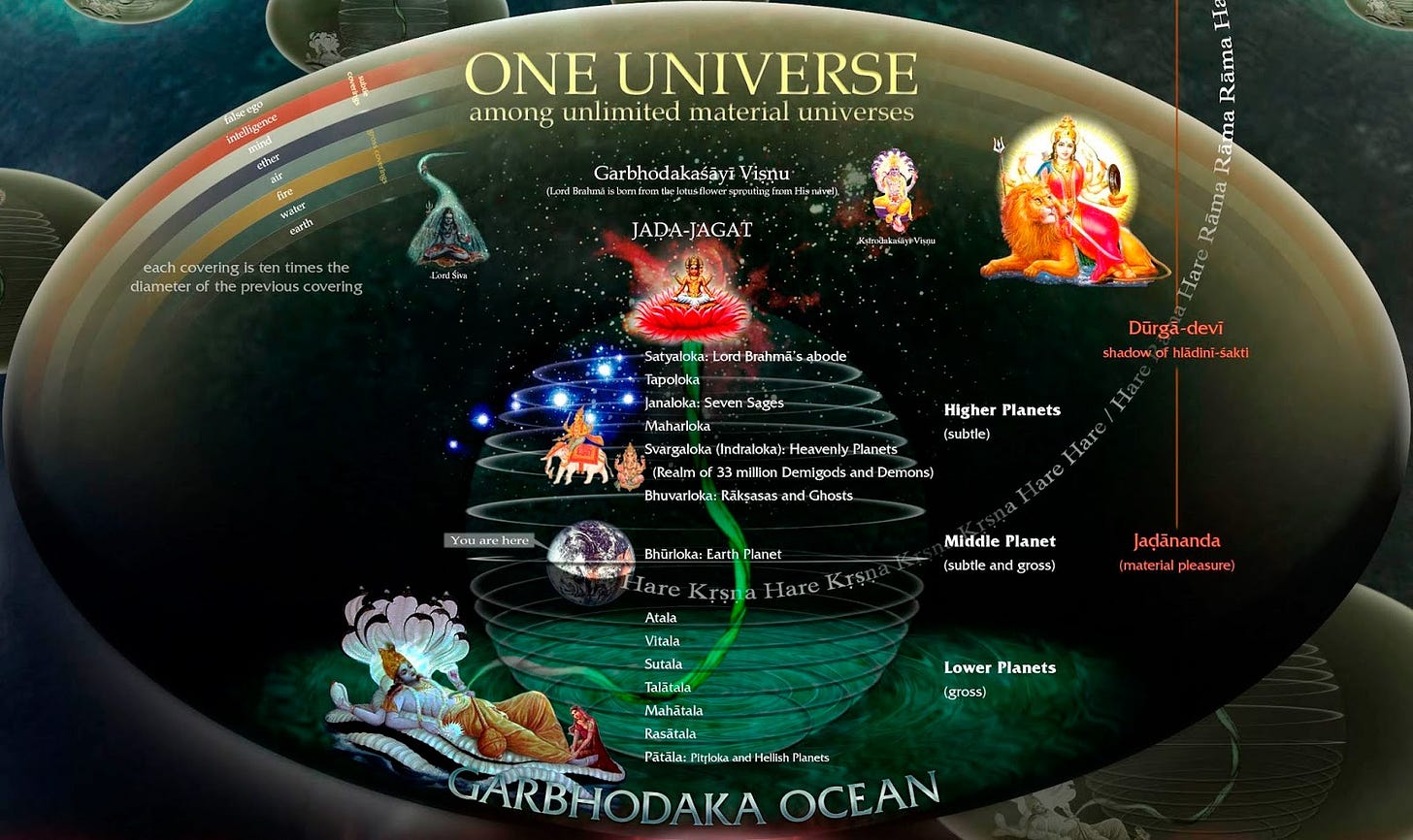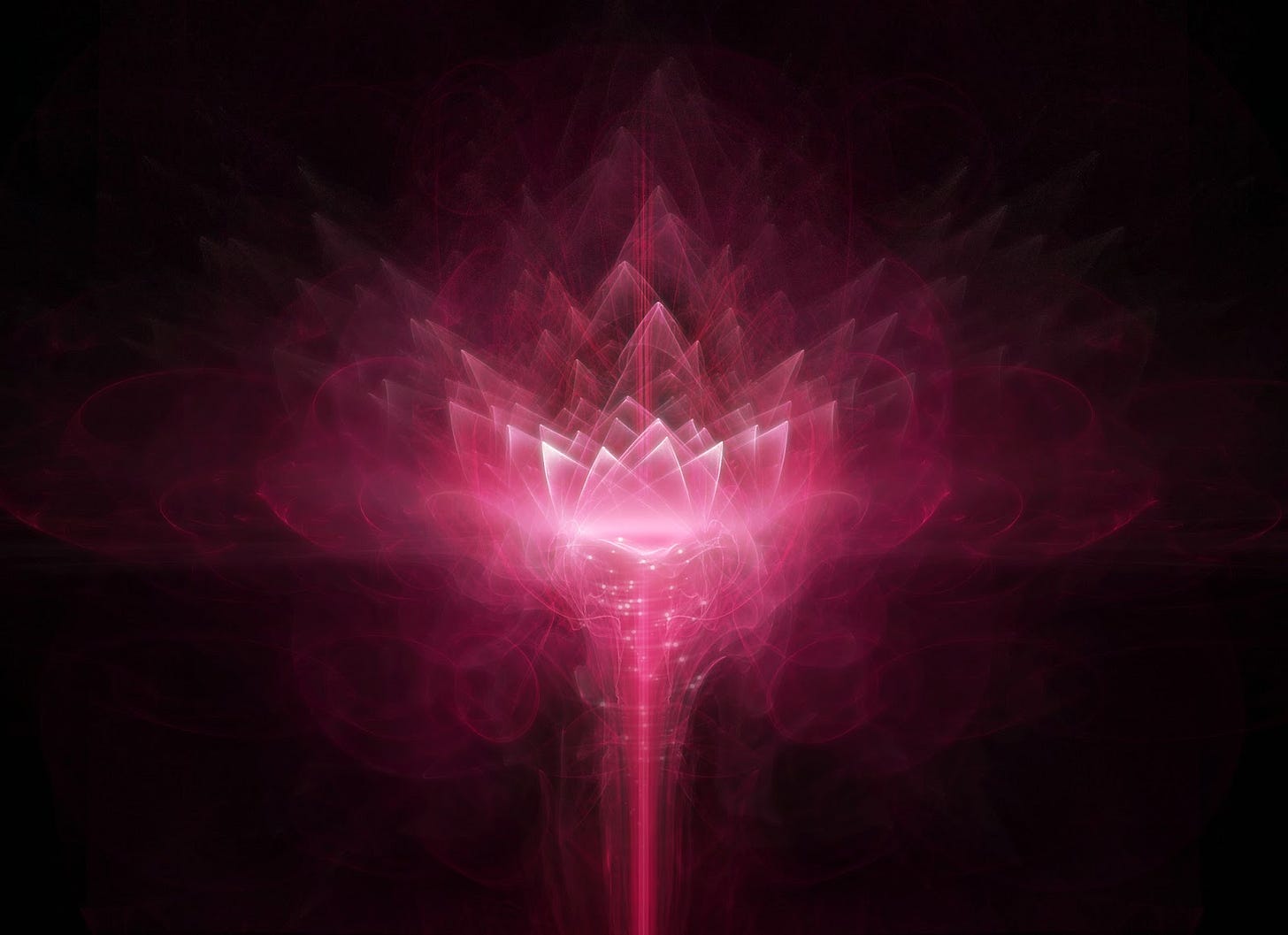The different planetary systems (The Intriguing Vedic Universe, ch.8)
Srimad Bhagavatam describes other planetary systems that comprise our universe. This hierarchical view illustrates the different levels of consciousness of inhabitants of different levels.
'The Intriguing Vedic Universe' was my first book on Vedic cosmology, explaining the mysterious universe described in the Srimad Bhagavatam. It describes not just the physical aspects, in a level of detail that rivals modern science, but also the metaphysical aspects, the missing aspect that is missing in the modern perspective.
Chapter 8: The different planetary systems
Apart from our immediate surroundings, Srimad Bhagavatam describes other planetary systems that comprise our universe. This hierarchical view of the universe illustrates the different levels of consciousness of inhabitants of different levels.
Goloka Chart
The Asuras, races that have a consciousness too much focussed on matter, live under the ground, without access to the light of the sun. In the Vedic Universe, their abodes are organized in the lower planetary systems, below our plane. Many of these are described as heavenly realms, where the inhabitants live in great material opulence and try to enjoy their senses to the fullest extent, while others are not so desirable. At the bottom are the hellish planets, where souls that committed serious crimes go to pay for their debts before they can take their next births. To fall into these lower realms can lead to a very difficult and painful time, therefore the Puranas alert us to the existence of such places so we may avoid the course of actions that leads there. Modern people tend to reject the idea of hell, preferring to believe that there is no life after death, or that everyone they care about will go to paradise, but just putting one's head inside the earth like this can lead to serious risks. One who ignores the advice of the sastras and leads a sinful life can face a very unpleasant reality after death.
In any case, what is more interesting are the higher planetary systems, to which one can ascend to the degree he can purify and elevate his consciousness through the practice of a spiritual process.
The closest planetary system to us is Bhuvarloka, where different subtle beings live, notably the Yaksas and Rakshasas. It’s described that their realm starts in the upper atmosphere, very close to us, but despite this, we can’t see it, since they live in a subtle dimension. Due to this proximity, however, they can easily contact human beings, which leads to many mystical experiences narrated through history. They are a mixed bag, including benevolent and malevolent entities.
These beings from Bhuvarloka are however different from ghosts (disembodied human beings living in our plane) because they live on a plane where they have different sense objects and can thus enjoy life just as we do, different from ghosts that are subtle beings stuck in a gross plane, where they can’t interact with people or objects. This plane of Bhuvarloka is described as a beautiful place with lakes and forests, controlled by Kuvera, who possesses great material opulence.
In the model of the Universe described in the Srimad Bhagavatam, this abode is around Mount Sumeru, immediately above our plane. During their exile, the Pandavas went there using mystical passages through the Himalayas, and Bhima even fought the army of Yaksas of Kuvera.
Higher is the planetary system of Swargaloka, where the Devas live in great delight. What is one year for us equals just one set of day and night in their abode, and consequently one year for them equals 360 years in our plane. On many of these planets, the inhabitants live for 10,000 of such celestial years, and some of them live for even longer periods. Indra reins for a manvantara, which equals more than 300 million years of our time.
The main difference between the Devas and Asuras is that the first group has a subtle consciousness, focused on subtle material enjoyment, connected with music, dance, and arts, while the second group has a gross consciousness, focused on material objects and gross enjoyment thorough tact, vision, hearing, smelling and taste. One group is interested in the subtle aspects of matter, while the other is interested in the gross aspects (this difference is explained in the book “Mystic Universe”, by Ashish Dalela). The main difference however is that the demigods are devotees of the Lord and cooperate with Him in the conduct of universal affairs, while the demons are envious of God and desire to just exploit the material nature.
Higher still are the higher planetary systems of Maharloka, Janaloka, and Tapoloka, inhabited by pure souls who are very serious about the path of self-realization. These realms are described in detail by Sanatana Goswami in the Brihad Bhagavatamrta. The souls in Maharloka live in great serenity, living in a pristine environment and dedicating their time to chant mantras and offer oblations to the fire, while souls in Janaloka and Tapoloka practice meditation.
There are other abodes described in Srimad Bhagavatam, including the abodes of the Saptarishi and Druvaloka, which is a spiritual planet appearing inside our universe, as well as others. These different abodes can be observed from Earth as the numerous stars we see in the night sky.
Above all, there is Brahmaloka, the abode of Brahma, the architect of this particular Universe. Brahmaloka is a very subtle abode, which is not observable from Earth. Hierarchically, it is situated at the very top. During the existence of the Universe, many pious souls gradually elevate themselves through the different planetary systems, up to this level, where they can continue living until the end of the Universe. When the Universe reaches its end, all these pious souls go alongside Brahma to the spiritual realm.
One important point when we study the Vedic Universe is the distances. All the measurements of the universe given in the Puranas are based on a unit called yojana. This is a measure of distance based on the characteristics of the human body, much like the inches and feet used in the imperial system.
One definition is that a yojana equals 8,000 times the height of a man. Another is that it equals 32,000 sets of 24 finger widths. Yet another definition states that a yojana equals four times the maximum distance a healthy man can shout and still be heard. That’s one of the reasons the length of the yojana varies through different sources, sometimes as 5 miles, 8 miles, etc.
Similarly, there is reason to contemplate the possibility that the yojana may vary across the cosmos, reflecting the perception of distance of the inhabitants in different planetary systems. As food for thought we can mention that according to the description of the Srimad Bhagavatam and other Puranas, the demigods are gigantic. It’s described that Lord Shiva is almost as big as Great Britain, for example.
Therefore, although Bhu-Mandala is only 500,000,000 yojanas from one extreme to the other (roughly the size of our solar system), the vertical dimension could be extraordinarily bigger, since the size of the yojana would become exponentially bigger as one advances to higher planetary systems.
If one accepts this idea, the Universe starts to look more like a cone, where the narrow side represents the lower levels of consciousness of human beings and Asuras, and the large side represents the higher states of consciousness of more elevated beings. In this model, Bhu-Mandala is on the narrow side of the universe, and thus its dimensions are relatively modest on a cosmic scale, while higher planetary systems are on the wide side, which is practically infinitely big. This view is capable of harmonizing the descriptions of the Puranas with the huge cosmic distances that can be observed in modern astronomy. The main point is that although we are limited by such distances, higher beings are not.






